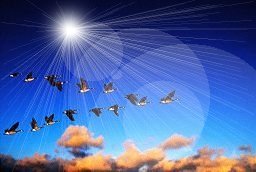|
restoring our biblical and constitutional foundations
|
A Fowl Lesson
When Luther reformed the content of the Gospel, he left the outer forms of the church essentially untouched. I believe it is time for new wineskins, for a reformation of structure. This is as much a theological issue as was the return to justification by faith during the Reformation. Only now the issue is not soteriological but ecclesiological.
As God changes the church, one area He is developing is the concept of Body Life – the notion of believers ministering to other believers in the power and love of the Holy Spirit. The New Testament church was a mass of small groups (house churches) where elders were no more than a part of the whole and where the whole spiritual organism flourished by the individual “ministers” (the believers themselves) finding their proper role and place in the church. The key was mutual sharing, fellowship, and participation – believers functioning as “priests” instead of the heavy professionalism we find today. They realized that God entrusted His Body not into the hands of an administrative bureaucracy but into the hands of believers who took the “one anothers” of Scripture seriously.
Modern Christianity has fled from the doctrine of the priesthood of all believers. There is very little “one-anothering” taking place in many of our congregations. Just as we have cars full of single people, so the church is marked by organized artificial performances in which the majority of believers are mere passive observers.
A reader once sent me a link to a wonderful
graphic entitled “Lessons from the Geese.” From the window of my home
office I have often watched these beautiful birds over-flying our farm and
marveled at the beauty and symmetry of their formations. So when I first
saw the graphic, its spiritual applications
 immediately
struck me, for it is a wonderful metaphor of the church and the priesthood
of believers.
immediately
struck me, for it is a wonderful metaphor of the church and the priesthood
of believers.
Here are the “Lessons from the Geese”:
Lesson #1: As geese flap their wings, they create an uplift for the bird following. By flying in a V formation, the whole flock adds 71 percent greater flying range than if any bird were to fly alone.
The church is a team. Each of us has a job to do within the Body, even if it often seems minimal. But the success of the team is dependent on the efforts of us all.
Lesson #2: Whenever a goose falls out of formation, it suddenly feels the drag and resistance of trying to fly alone, and quickly gets back into formation to take advantage of the lifting power of the bird immediately in front.
None of us can go it alone. We are meant to be with the Body, which grows by the proper functioning of its individual parts and so builds itself up in love. We have to “fly” together lest we be sidetracked by “every wind of teaching" and find ourselves flying alone.
Lesson #3: When the lead goose gets tired, it rotates back into formation and another goose flies at the point position.
God has always provided leadership for His people. But no one leader can “do it all.” Moreover, churches need leaders who are “flying” in the right direction, following sound biblical doctrine. As Hebrews 13:7 states: “Remember those who lead you, who have spoken the word of God to you, whose faith follow, considering the outcome of their conduct.”
Lesson #4: The geese in formation honk from behind to encourage those up front to keep up their speed.
We need to encourage one another in the Body of Christ. Paul wrote, “Rejoice with those who rejoice, and weep with those who weep” (Rom. 12:15), and Heb. 10:24-25 says, “Let us consider one another in order to stir up love and good works, not forsaking the assembling of ourselves together, as is the manner of some, but exhorting one another, and so much the more as you see the Day approaching.”
Lesson #5: When a goose gets sick or wounded or is shot down, two geese drop out of formation and follow it down to help and protect it. They stay with it until it is able to fly again or dies. They then launch out on their own, with another formation or catch up with the flock.
We should never abandon a wounded brother or sister. James notes: “Brethren, if anyone among you wanders from the truth, and someone turns him back, let him know that he who turns a sinner from the error of his way will save a soul from death and cover a multitude of sins” (James 5:19-20). Peter adds, “And above all things have fervent love for one another, for love covers a multitude of sins” (1 Pet. 4:8).
What, then, can we conclude except that just as the geese take care of each other, we as believers are called upon to love all true Christian brothers, and to love them in such a way that the world might observe our love in action. A return to biblical norms of doing church must involve a renewed emphasis on the notion of mutual ministry rather than reliance on professional clergy. The instructions of 1 Corinthians 14 give approval for every member ministering during our assemblies, though in a decent and orderly way. There is nothing in the Scriptures that would imply that only one man is to do all the talking on Sunday morning.
As mature “geese” (saints), it is up to all of us to do “the work of the ministry” (Eph. 4:12).
February 7, 2014
David Alan Black is the editor of www.daveblackonline.com.